Topic: Asteroids Comets And Meteors
Asteroids Comets And Meteors
The solar system object in the photograph below is 56 kilometers long.
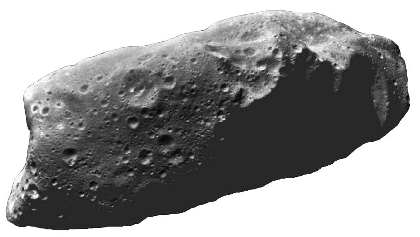
The object in the photograph is most likely
(1) an asteroid
(2) Neptune
(3) Earth’s Moon
(4) Mercury
A 65.5-million-year-old impact crater in Mexico provides evidence for the cause of the
(1) breakup of Pangaea
(2) evolution of the earliest corals
(3) Alleghenian orogeny
(4) extinction of ammonoids
Which event is inferred to have contributed to the significant global climate change that may have caused the mass extinctions of organisms at the end of the Late Cretaceous Epoch?
(1) the Big Bang
(2) an asteroid impact
(3) formation of Pangaea
(4) shifting of Earth’s magnetic poles
The asteroid Ceres lies at an average distance of 414 million kilometers from the Sun. The period of revolution of Ceres around the Sun is approximately
(1) 438 days
(2) 687 days
(3) 4.6 years
(4) 12.6 years
The chart below describes some components of the solar system.
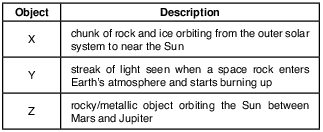
Letters X, Y, and Z identify which components of our solar system?
(1) X = asteroid; Y = meteor; Z = comet
(2) X = asteroid; Y = meteor; Z = moon
(3) X = comet; Y = meteor; Z = asteroid
(4) X = comet; Y = moon; Z = meteor
The map below shows the location of the Chicxulub crater, which was formed when a massive asteroid impacted Earth 65.5 million years ago.
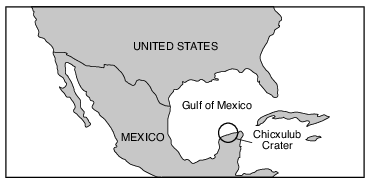
Scientists infer that this impact contributed to the extinction of
(1) trilobites
(2) gastropods
(3) many land plants
(4) placoderm fish
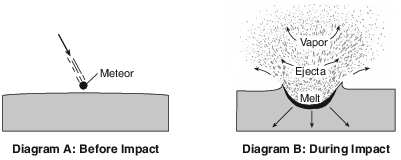
Which statement best explains how global climate would most likely be affected after this large meteor impact?
(1) Large quantities of ejecta in the atmosphere would block insolation and lower global temperatures.
(2) An increase in vapor and ejecta would allow radiation to escape Earth’s atmosphere and lower global temperatures.
(3) Ejecta settling in thick layers would increase the absorption of insolation by Earth’s surface and raise global temperatures.
(4) Forest fires produced from the vapor and ejecta would raise global temperatures.
The impacts of large asteroids on Earth are inferred to be associated with
(1) free oxygen entering Earth’s atmosphere
(2) seafloor spreading
(3) the creation of subduction zones
(4) global climatic changes
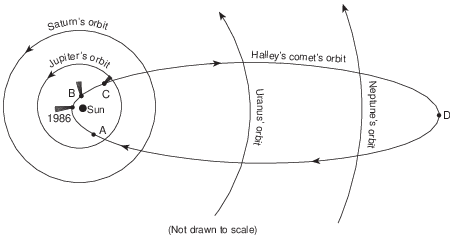
Based on the pattern shown above, which diagram best represents the correct position of the comet’s tail at location A relative to the Sun?
(1) 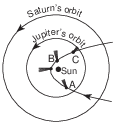
(2) 
(3) 
(4) 
Many scientists infer that one cause of the mass extinction of dinosaurs and ammonoids that occurred approximately 65.5 million years ago was
(1) tectonic plate subduction of most of the continents
(2) an asteroid impact that resulted in climate change
(3) a disease spreading among many groups of organisms
(4) severe damage produced by worldwide earthquakes
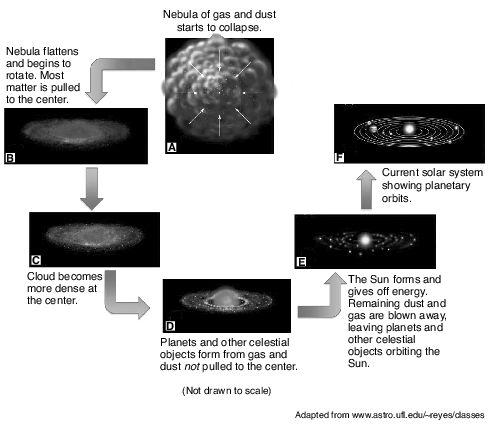
Most asteroids formed in a belt located between 329 million and 478.7 million kilometers from the Sun. Identify the two planets located on either side of the asteroid belt. [1]
________________________________ and _________________________________
Allow 1 credit for Mars and Jupiter.

The meteor impact debris was deposited at the time trilobites became extinct. State the age, in million years, of this debris layer. [1]
million years
Allow 1 credit for 251 million years.
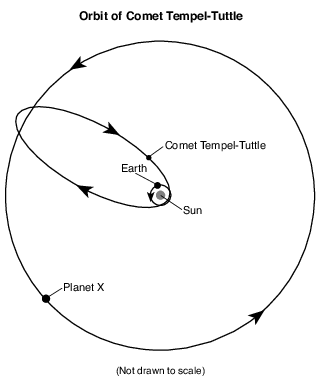
Comet Tempel-Tuttle
Comet Tempel-Tuttle orbits our Sun and is responsible for the Leonid meteor shower event observed from Earth. This meteor shower occurs every year in November and is visible in the night sky as Earth passes through the debris left in space by this comet. The debris from the comet produces meteors that are smaller than a grain of sand, which enter Earth’s atmosphere and burn up in the mesosphere temperature zone. Comet Tempel-Tuttle’s orbital distance from the Sun ranges from about 145 million kilometers at its closest approach to 2900 million kilometers at its farthest distance. Its two most recent closest approaches to the Sun occurred in 1965 and one revolution later in 1998.
Identify the name of the object located at one of the foci of the elliptical orbit of Comet Tempel-Tuttle. [1]
Allow 1 credit for the Sun.
The center of the asteroid belt is approximately 503 million kilometers from the Sun. In image below, draw an X on the model between two planets to indicate the center of the asteroid belt. [1]

Allow 1 credit if the center of the X is drawn in or touches the box shown below.
• Note: Allow credit if a symbol other than an X is used.
• 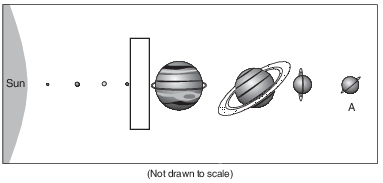
The center of the asteroid belt is approximately 404 million kilometers from the Sun. State the name of the planet that is closest to the center of the asteroid belt. [1]
Allow 1 credit for Mars.
